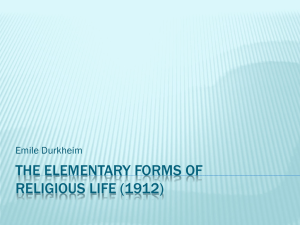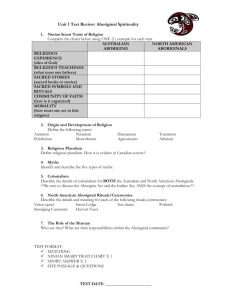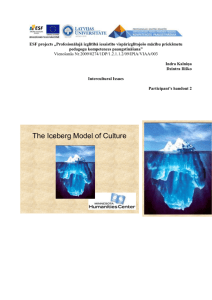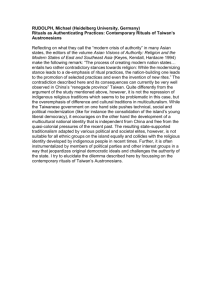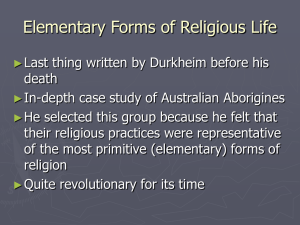Functionalist Approach to Popular Culture Presentation
advertisement
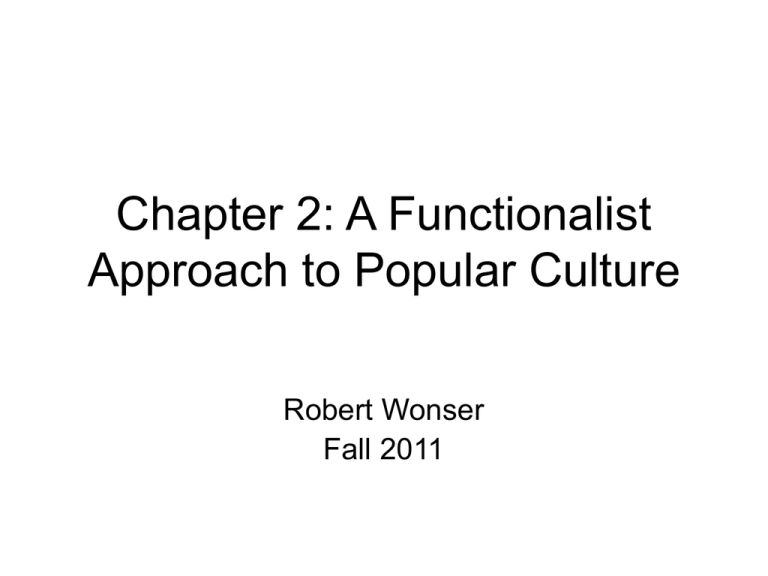
Chapter 2: A Functionalist Approach to Popular Culture Robert Wonser Fall 2011 Theoretical takes on Popular Culture • Functionalist: culture “functions” as the social glue that generates solidarity and cohesion within human groups and societies. • Contemporary collective rituals—hs football games, parades, pep rallies—serve to forge emotional bonds of recognition, identity, and trust within communities and social groups • Allows strangers to communicate with each other in public • Describes the uses of mass entertainment (their functions) in generating solidarity in large anonymous communities Emile Durkheim • Following Durkheim, ALL culture (including popular) is founded on non-rational foundations and is upheld through the rituals and the distinction between the sacred and the profane • The scared is dangerous and extremely important; it must be approached seriously, respectfully and with due preparation • The profane are the rest of the world, all other things you can deal with matter-of-factly, with whatever mood you wish and for whatever purpose • Rituals are procedures by which people must conduct themselves in the presence of things that they believe to be scared. • Ordinary non-ritualized behavior is how you behave in the presence of the profane • All of these are inherently collective; they need other people, other members of your group Culture as Religion • Durkheim argued that religious symbols or images represented not merely gods or beliefs, but the religious group members themselves and their collective conscious just as national flags represent not only the idea of a nation but the actual citizens. • Religious rituals and practices create symbolic boundaries demarcating the separation of the sacred and the profane elements of the universe What does this mean? How do Americans react when it is burned? The Importance of Rituals • If people share the same sacred emblems and holy names, the same doctrines, they know they belong to the same ritual community. • They can identify with one another as members of a group that has feelings of collective solidarity and strength. • Even short conversations are mini rituals that affirm one’s identity in a select group and boost our emotional energy. • Sacred symbols also tell us who is not a part of our group. Emotional Energy • A strong benefit of group membership (society, a cultural group, or subcultural group) is the emotional energy one receives from taking part in social gatherings • Durkheim called this “collective effervescence” or a shared feeling of identity in which the individual members of the group (whether tribe or congregation, or in our case music fans or sports fans) experience waves of emotion, a sense of unity and togetherness How does it feel to be in either situation? • The basic elements of religious life— shared symbols and images, imagined boundaries separating the sacred from the profane, and rituals that help participants generate collective effervescence—that provide the social glue that binds societies through thick and thin. Rituals of Solidarity and Social Cohesion in Popular Culture • Symbols, rituals and practices surrounding pop culture’s production and consumption can bring people together by generating a shared sense of solidarity • Like Native American and Aboriginal tribes, sports teams are often signified by animalistic totems. Ex: Chicago Bears, Atlanta Falcons, Miami Dolphins, etc. What brings these people together? Imagined Community • Imagined community Live televised events have the potential to generate similarly effervescent experiences among viewers who, despite their lack of physical proximity to one another, still feel as if they are members of a collective audience sharing the simultaneity of a moment • Can offer greater feelings of solidarity among audiences while the actual events are chaotic Popular Culture as a Resource for Public Reflection • Pop culture’s movies, tv shows, music, etc are the stories we tell ourselves about ourselves • Celebrities, regardless of how little we care for them as individual people, we obsess over their reported comedic highs and tragic lows because their stories provide resources for reflecting on the social world and the human experience. • Modern day morality plays, Aesop’s fables and traditional folktales: give tangible form to otherwise abstract ethical dilemmas concerning the nature of human relations and social behavior Mad Men • What does Mad Men tell us about us? • Set in the sixties, we can see how ‘we were’ • Sexism, homophobia, racism Rituals of Rebellion • Rituals of rebellion are seemingly transgressive displays which ultimately restore and solidify the social order. • Rituals represent a kind of institutionalized protest that allows subordinate group members to momentarily let off steam without actually granting them real power for a significant period of time Rituals of Rebellion • By temporarily inverting the hierarchical structure of the social order as a form of play, such rituals remind participants of the dominant status norms that organize and regulate society on a more daily basis. • How does popular culture fulfill this function? Darker Functions of Popular Culture • How rebellious are these acts? • Does their ritualized character takes out their bite? – All political parties are attacked • Does the comedic atmosphere in which the attacks are levied diminish how seriously viewers will take the criticism? • Do these collective rituals of solidarity ultimately bolster the legitimacy of those in power by artfully appropriating dissent? Do we critically evaluate their critiques? Darker Functions of Popular Culture • Promoting stereotypes, myths and fears • Portrayal of sexist, racist, classist and homophobic images (including ads) • Reinforcement of status quo • Propagating of the American Dream ideology • Pop culture provides not only a resource for reflection but for distraction • The word ‘sport’ derives from the French desporter, which means “to divert, amuse, please, play” • Only 0.03% of all high school men’s basketball players make it to the NBA

